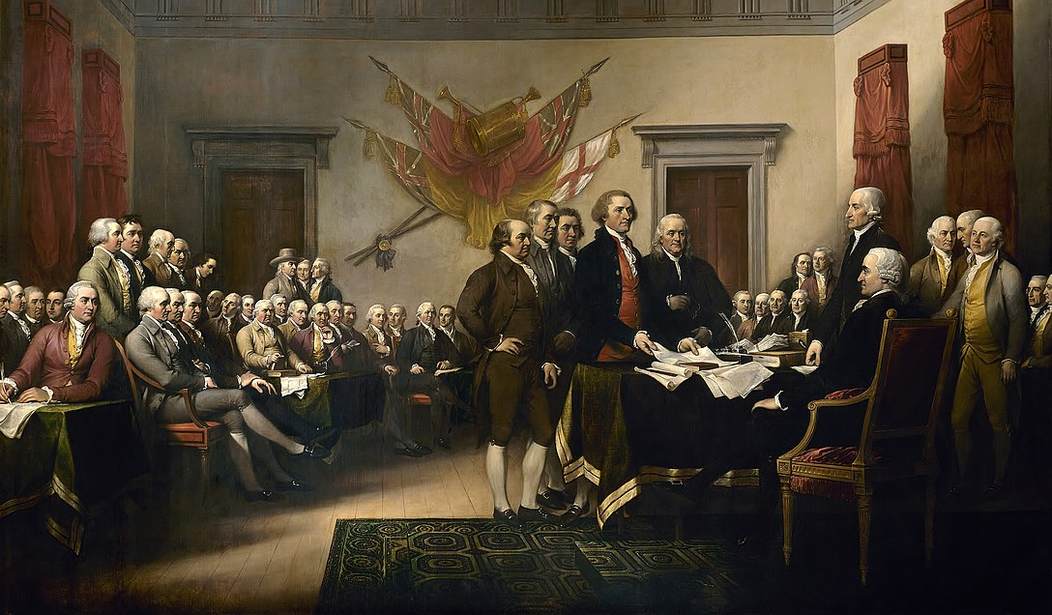Earlier this month, the National Archives and Records Administration (NARA) released a report on combatting the “institutional racism” at the National Archives. The report represents the creeping invasion of institutional woke-ism, complete with calls for a new lexicon to push “anti-racist terminology” and a permanent bureaucracy to pay woke activists make sure NARA doesn’t fall back into its institutionally racist ways.
Yet perhaps the worst part of the National Archives report involves “reimagining” the National Archives rotunda in order to root out “institutional racism.” Specifically, the NARA report claims that the Declaration of Independence, the Constitution, and the Bill of Rights are not by themselves “Charters of Freedom,” so the National Archives must retire that phrase or change it.
“Racism is embedded in the history and current practices of NARA,” the report insists. “Dismantling such structural racism will require vast changes to NARA’s work culture at every level as well as an ongoing and active committment [sic] to anti-racist work througout [sic] the agency’s future.”
Recommended: Head of the Joint Chiefs Repeats CRT Propaganda Trashing the Constitution
The document lists many recommendations to root out “systemic racism,” including an initiative to “Reimagine the Rotunda.” The project aims to “recontextualize” the “murals and architectural elements” and to install a new exhibition in order to “create a more inclusive and historically accurate tribute to the nation’s founding.”
Some of the concrete recommendations are innocent enough. The report notes that when architect John Russell Pope designed the National Archives Rotunda, he included four niches in the walls “likely intended to be filled with sculptural figures.” The report rightly notes that “these empty spaces are ready-made platforms for new memorials,” which could celebrate women, Native Americans, and blacks who contributed to the Founding.
The report also suggests including documents alongside the Declaration of Independence, the Constitution, and the Bill of Rights in order to highlight the complexities of American history. While some of the report’s suggestions may raise objections, this basic idea seems rather fitting for the Rotunda.
Yet the report does not just fault the Rotunda for failing to include tributes to racial minorities and women — it also attacks the very idea that the Rotunda should be a shrine to the founding documents.
“Architect John Russell Pope designed the National Archives Rotunda as a shrine to the founding documents of the United States. Its neoclassical architecture ties American democracy to ideals of Ancient Greece and Rome. The oculus, marble columns, bronze medallions, and other architectural elements speak of significance, permanence, and security,” the report notes.
Recommended: Parents Are Revolting, Teachers Are Resigning, and Critical Race Theory Is to Blame
The report claims that the Rotunda’s view of history is a product of the 1930s. “Its reverential, quasi-religious treatment of the Declaration of Independence, Constitution, and Bill of Rights does not adequately reflect a full history of the founding of the United States. And as we are learning through the comments of staff and visitors, some find the Rotunda’s language and imagery exclusionary,” the report claims.
NADA cites a survey in which “one respondent commented that it is tone deaf and oblivious to use the term ‘Charters of Freedom’ to refer to ‘documents that institutionalized slavery.’ Another reported a Black senior congressional staffer rejected the term outright. ‘Those aren’t my Charters of Freedom,’ he said.”
“For him and many others, these documents represent the entrenchment of chattel slavery, denial of rights to women, and triumph of European colonists over the original inhabitants of North America,” the report claims.
For these reasons, “the Archives must either retire the expression ‘Charters of Freedom’ or expand its meaning to encompass additional documents (like the Reconstruction Amendments, 19th Amendment, and Civil and Voting Rights Acts) and display them with equal honor and reverence.”
By issuing this recommendation, NARA uncritically accepts these negative assessments of the Declaration and the Constitution. The report also suggests that a “Charter of Freedom” must be a perfect document.
Yet this is not the case. The Declaration of Independence is a “Charter of Freedom” even though it did not apply that freedom to everyone equally. The Constitution can still be a “Charter of Freedom” even though it also allowed the institution of slavery to continue.
As Martin Luther King Jr. declared in his famous “I Have a Dream” speech, “When the architects of our republic wrote the magnificent words of the Constitution and the Declaration of Independence, they were signing a promissory note to which every American was to fall heir.”
The Declaration of Independence and the Constitution are not just practical documents of their time — they are aspirational documents laying out the principles of liberty.
Yes, the Founders allowed slavery to continue. However, they notably excluded the phrases “slave” and “slavery” from the Constitution, as if in a nod to the fact that slavery itself contradicts the spirit of the Founding. The Founders also excluded slavery from the Northwest Territory in the Northwest Ordinance, one of the very first laws in the new United States.
Recommended: The Totalitarian Threat of Critical Race Theory Rears Its Ugly Head
Even one of the most demonized aspects of the Constitution — the Three-Fifths Compromise — illustrates the Founders’ struggle to limit the power of slavery and slave-holders. Many detractors have claimed that the Constitution considered black people to only count as three-fifths of a person, but that is false. Slaves — referenced in the Constitution as “those bound to service for a Term of Years” — counted as three-fifths for purposes of representation.
Slave-holding states wanted to count not just free people but also slaves for purposes of representation. This would artificially pad their numbers, since slaves did not get to vote for their representatives. Had slaves counted as a full person for purposes of representation, that would have given slave states more power in the federal government.
Many activists and educators, inspired by Marxist critical race theory (CRT) twist history in this way, claiming that the founding documents and the institutions they created are inherently racist.
Unfortunately, this demonization runs through the NARA document — specifically in the Rotunda section.
For the Rotunda, the document suggests some brow-beating exhibits along these lines. NARA recommends that the Rotunda include an “elucidation of references to slavery in the Constitution and Bill of Rights, the slaveholding interests of many of the founders, and compromises to appease Southern States” next to the founding documents for perspective. Alternately, NARA recommends an “invitation to discuss and reflect on contradictions inherent in the soaring rhetoric of the time and the reality of the experiences of those who were not White men of property.”
The NARA document also includes positive recommendations: stories about the potential positive influence of the Iroquois Confederacy’s democratic principles on the Founding; acknowledgement of opposition to slavery at the time of the American Revolution and black slaves’ struggles toward freedom; and a celebration of individuals like Frederick Douglass, Ida B. Wells, and Susan B. Anthony.
These positive recommendations, like the idea of including iconic black, Native American, or female heroes in the Rotunda niches, arguably fit the reverent atmosphere, which is extremely fitting for the aspirational founding documents.
Yet the negative exhibits, the idea of striking “Charters of Freedom” from the founding documents, and a few other recommendations amount to an insult to the Founders and an attack on the very idea of treating the Founding with reverence.
The document seriously recommends that the National Archives Rotunda “stage dance or performance art in the space that invites dialogue about the ways that the United States has mythologized the founding era.”
The National Archives Rotunda can honor the contributions of black, Native American, and female Americans without demonizing the Founders or destroying the Rotunda’s reverent atmosphere. Sadly, the NARA report threatens to destroy the Rotunda in the name of diversity.
The report acknowledges that “Reimagining the Rotunda will stir controversy” and it recommends that the National Archives “present the project as a means of adding to, rather than repudiating, the celebration of the nation’s origins.”
Yet the overemphasis on race and trumped-up claims of “institutional racism” reveal just how hollow that messaging truly is. The report suggests that a staff member was right to say that “the Rotunda ‘should ideally connect all Americans to NARA and the history of the U.S., not just white Americans,'” as if only people who ostensibly share the skin color of the Founders can celebrate the Founding.
Recommended: Trump Commission Explains Why Critical Race Theory Is Incompatible with the Declaration of Independence
Americans should reject this report and the ideology behind it. The National Archives Rotunda fosters reverence for the founding documents — and Americans should not let CRT destroy that reverence.









Join the conversation as a VIP Member